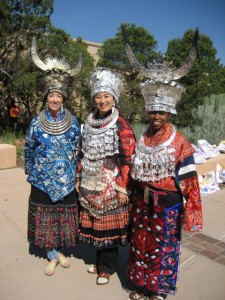Getting A Shipment from Haiti
People that know Beyond Borders/It’s Cactus might know us from retail and wholesale trade shows with our colorful booth full of sculpture displays and fresh flowers. Or they might know us from our retail shop off of Highway 68 in Toro Park just outside of Salinas, CA. But a HUGE part of the work that goes on for Beyond Borders/It’s Cactus takes place at our warehouse. It too is just outside of Salinas, and though it is known to few, it is there that the receiving, storing, and shipping takes place.
Every month, the process is repeated: An order is sent to Haiti, along with an average amount of $30,000 in prepayment, which is distributed among the artists of the village. About that same time, the completed products ordered the previous month are sent to California from Haiti. Just this past Tuesday, a shipment arrived at the warehouse – almost THREE TONS of folk art metal sculptures to be unpacked, sorted, inspected, and stored until they are sold and shipped to our customers here in the States and beyond.
Among our “warehouse warriors” there is excited anticipation as the delivery truck arrives. Everyone falls into rhythm as crates are off-loaded and pried open. Pieces come wrapped, but things being what they are in Haiti, wrapping materials simply consist of whatever is available at the time. Sculptures are variously bundled in bits of wire – even barbed wire! – cording, electrical tape, masking tape, surgical tape, plastic strips, fabric strips, or some combination thereof. In between sculptures, we’ve found newspapers, tissue, plastic sheeting and children’s homework. A surprise in every package – in more ways than one!
Contributed by Linda for Beyond Borders/It’s Cactus

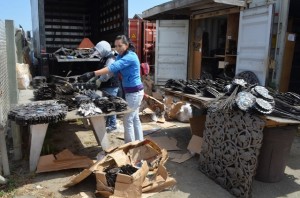
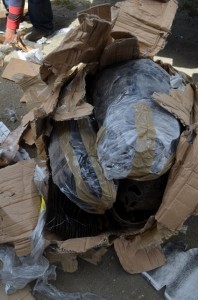
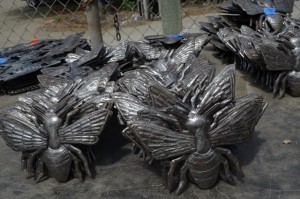
![BlackMadonna[1]](https://blog.itscactus.com/wp-content/uploads/2013/04/BlackMadonna1-201x300.jpg)
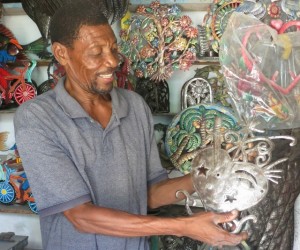
![ecu8057[1]](https://blog.itscactus.com/wp-content/uploads/2012/07/ecu805711-196x300.jpg)
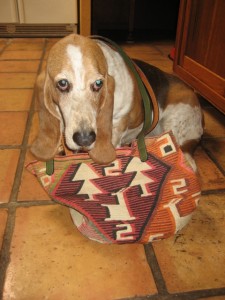 That’s how mine looked, the day it was given to me. A beautiful shigra with bold geometric patterns, animals, trees, numbers, and letters in pink, red,orange, brown and black and two long fiber straps. Two days later, however, it had been altered by my dog, who decided to add a little fiber to her diet, I guess. She had a mouthful and my straps were a tattered mess. I said, “Oh no, no, no, you naughty Little Darling,” or maybe something a tiny bit stronger, and saved what I could. I retied the ends and that worked well enough for a while, but admittedly, they were a little short. Eventually I replaced them entirely with leather. This was at no small expense, but in all honesty, I think it was worth the price. The new handles nicely preserve the integrity of my shigra and I happily carry a fantastically functional and fashionable Andean textile everywhere I go. My basset hound too, is pleased with my shigra’s stylish utility and she is very glad she didn’t eat the whole thing after all.
That’s how mine looked, the day it was given to me. A beautiful shigra with bold geometric patterns, animals, trees, numbers, and letters in pink, red,orange, brown and black and two long fiber straps. Two days later, however, it had been altered by my dog, who decided to add a little fiber to her diet, I guess. She had a mouthful and my straps were a tattered mess. I said, “Oh no, no, no, you naughty Little Darling,” or maybe something a tiny bit stronger, and saved what I could. I retied the ends and that worked well enough for a while, but admittedly, they were a little short. Eventually I replaced them entirely with leather. This was at no small expense, but in all honesty, I think it was worth the price. The new handles nicely preserve the integrity of my shigra and I happily carry a fantastically functional and fashionable Andean textile everywhere I go. My basset hound too, is pleased with my shigra’s stylish utility and she is very glad she didn’t eat the whole thing after all. o how was it? Being there for the dual purposes of A) supporting the worthy goals of the Market and B) personal acquisition, I can tell you without reservation, it was GREAT! The high quality of the art and the variety of goods available is incredible. Plus, it’s such a treat – not to mention an education – to meet the artists. In many cases, there is the additional opportunity to see them demonstrate their craft. Throw in the chance to participate in an event that last year generated $17,300/booth for the artists to take home to their families and communities and WOW, you’ve got plenty to feel good about.
o how was it? Being there for the dual purposes of A) supporting the worthy goals of the Market and B) personal acquisition, I can tell you without reservation, it was GREAT! The high quality of the art and the variety of goods available is incredible. Plus, it’s such a treat – not to mention an education – to meet the artists. In many cases, there is the additional opportunity to see them demonstrate their craft. Throw in the chance to participate in an event that last year generated $17,300/booth for the artists to take home to their families and communities and WOW, you’ve got plenty to feel good about.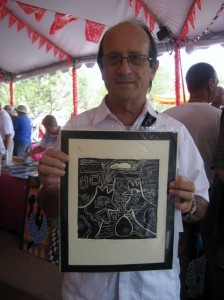
 NEXT TIME – for this has become a July tradition for me ranking right up there with fireworks on the Fourth – I will definitely purchase the early admission tickets again, if not go to the Market Opening Party on Friday night. You pay more for these – in the case of the Opening Party, quite a lot more. However, with the Market’s increasing popularity has come increasing crowds. That’s good in the Big Picture, but from a shopping standpoint, this means that by 10:00 and lasting until about 4:00 on Saturday, the booths do
NEXT TIME – for this has become a July tradition for me ranking right up there with fireworks on the Fourth – I will definitely purchase the early admission tickets again, if not go to the Market Opening Party on Friday night. You pay more for these – in the case of the Opening Party, quite a lot more. However, with the Market’s increasing popularity has come increasing crowds. That’s good in the Big Picture, but from a shopping standpoint, this means that by 10:00 and lasting until about 4:00 on Saturday, the booths do 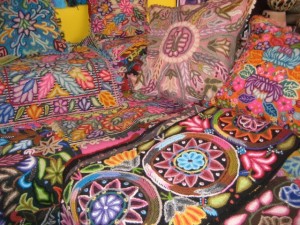
 become quite congested. From 4:00 until closing time at 6:00, it slows down and the tents become more navigable once again. Sunday, the second and final day, gets pretty reasonable after lunch, ” they say.” The risk there is that many of the “goodest goods” are long gone. Who wants to be saying “Coulda…shoulda…woulda,” at the end of the Market and still have money left in their pocket, begging to be spent? Not ME!
become quite congested. From 4:00 until closing time at 6:00, it slows down and the tents become more navigable once again. Sunday, the second and final day, gets pretty reasonable after lunch, ” they say.” The risk there is that many of the “goodest goods” are long gone. Who wants to be saying “Coulda…shoulda…woulda,” at the end of the Market and still have money left in their pocket, begging to be spent? Not ME! For color, cultural richness, and acquisitive opportunity, you can’t beat the International Folk Art Market. Held annually the second full weekend in July in Santa Fe, NM, this year’s Market holds plenty of promise. Beyond Borders has sponsored artists in the past, and though we’re not participating as a vendor this year, it’s not because it’s not worthy. It IS! By plane, train, automobile, or on horseback, if you can make it, GO!
For color, cultural richness, and acquisitive opportunity, you can’t beat the International Folk Art Market. Held annually the second full weekend in July in Santa Fe, NM, this year’s Market holds plenty of promise. Beyond Borders has sponsored artists in the past, and though we’re not participating as a vendor this year, it’s not because it’s not worthy. It IS! By plane, train, automobile, or on horseback, if you can make it, GO!
